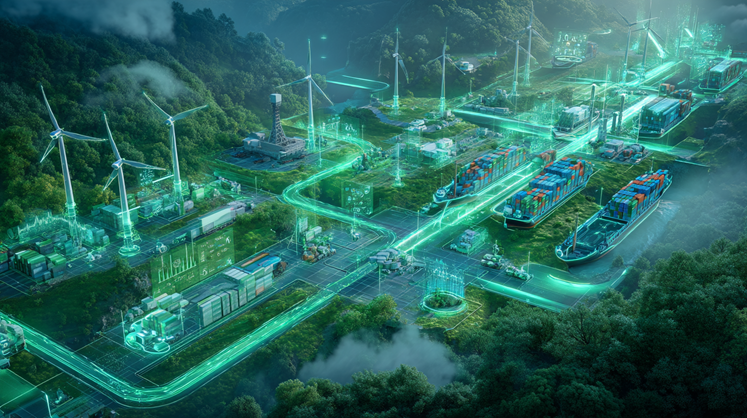You might think that sustainability in the transport industry is just a trend, but it’s actually essential for addressing the significant greenhouse gas emissions tied to domestic freight in Australia. With transport accounting for nearly 20% of our total emissions, the shift to low-emission solutions isn’t just beneficial—it’s necessary. This transition can improve urban livability and public health while boosting economic efficiency. But how do we get there, and what role can various sectors play in this essential transformation? Exploring these questions reveals an urgent need for change.
Importance of Sustainability in the Transport Sector
Understanding the importance of sustainability in the transport sector is vital for you as it directly impacts the environment, economy, and society.
By adopting sustainable practices, you can minimise harmful emissions, boost economic efficiency, and fulfill social responsibilities.
It’s not just about reducing your carbon footprint; it’s about building a better future for everyone.
Environmental Impact
As the transport sector continues to account for a significant portion of Australia’s domestic emissions, recognising the importance of sustainability becomes essential. In 2021, the sector contributed around 20% of total emissions, with freight alone responsible for nearly 40%. This stark reality highlights the urgent need for sustainable practices, especially considering that road transport makes up 83% of freight emissions.
By transitioning to low-emission solutions, you can significantly reduce the carbon footprint of the freight industry. For instance, implementing short-haul solutions could lead to an immediate 51% reduction in emissions. This isn’t just about numbers; it’s about enhancing urban livability and restoring ecological balance. Cleaner air and less congestion not only improve quality of life but likewise support healthier ecosystems.
With projections indicating that the freight sector will become the largest contributor to Australia’s emissions by 2030, immediate action is imperative. Focusing on sustainability isn’t merely an option—it’s a necessity for meeting climate targets and ensuring a cleaner, more efficient future for the transport system.
Embracing these changes will lead to a more sustainable and resilient Australia.
Economic Efficiency
Sustainable practices in the transport sector not only address environmental concerns but additionally improve economic efficiency, making them vital for Australia’s freight industry. By transitioning to low-emission vehicles and alternative fuels, you can achieve significant cost savings.
For instance, road transport accounts for 83% of freight emissions, and adopting electrification or Battery Electric Vehicles (BEVs) can drastically cut fuel costs, which represent a hefty 35% of long-haul and 20% of short-haul operating expenses.
Moreover, intermodal rail freight generates 16 times less carbon emissions per tonne-kilometer than road freight. This method not only reduces carbon footprints but also improves supply chain efficiency, providing a cost-effective alternative.
The integration of advanced technologies and sustainable infrastructure additionally boosts operational efficiency in the freight sector, leading to increased productivity and lower operational costs.
As Australia moves toward a low-carbon future, embracing sustainability isn’t just about compliance—it’s about making smart, economically sound decisions that benefit your bottom line and the environment.
Social Responsibility
Addressing economic efficiency in the transport sector naturally leads to the conversation about social responsibility. As you consider the impact of freight emissions, it’s clear that sustainable practices aren’t just a nice-to-have; they’re vital for social equity. By reducing air pollution from transport, you not only help the environment but likewise improve public health, potentially saving lives.
With nearly 185,000 deaths linked to vehicular emissions each year, your commitment to sustainable solutions can make a real difference.
Community engagement plays an important role in this transition. When freight companies adopt electric and alternative fuel vehicles, they contribute to cleaner air and improved urban livability, benefiting all community members.
Promoting sustainable transport not only addresses climate change but additionally creates economic opportunities, including jobs in green vehicle manufacturing.
Supporting these initiatives encourages a sense of responsibility within the transport sector, ensuring that all Australians can enjoy a healthier environment.
By prioritising sustainability, you participate in shaping a transport system that values both economic efficiency and the well-being of current and future generations.
Together, we can drive meaningful change in the industry.
Key Elements of Supply Chain Sustainability
When considering supply chain sustainability, you’ll want to focus on three key elements: green, transparent, and circular supply chains.
Each of these components plays a vital role in reducing emissions and improving efficiency in domestic freight.
Green Supply Chains
To guarantee a greener future in the transport industry, integrating green supply chains is essential for reducing environmental impacts across logistics and transportation. These supply chains focus on green logistics and sustainable sourcing, aiming to minimise the carbon footprint of freight operations. Since freight accounts for nearly 40% of Australia’s transport emissions, it’s vital to adopt these practices.
By implementing green supply chain strategies, you can achieve a 51% immediate reduction in emissions through short-haul solutions. Collaborating with local suppliers and stakeholders not only optimises resource use but additionally minimises waste, enhancing the sustainability of the entire network.
Furthermore, harnessing technologies like AI and IoT in your logistics management promotes predictive maintenance and operational efficiency, leading to further emissions reductions.
When you prioritise green supply chains, you’re investing in a cleaner, more efficient future. This approach not only addresses the increasing contribution of road transport to emissions but also encourages economic resilience.
Transparent Supply Chains
While many might overlook the importance of transparency in supply chains, it plays a critical role in improving sustainability in the transport industry. Supply chain transparency allows you to track emissions accurately, which is vital for meeting Australia’s climate targets, as the transport sector is expected to become the largest contributor to domestic emissions by 2030.
When you share data efficiently among stakeholders, it boosts operational efficiency and supports well-informed choices.
The Australian Government recognises this need, mandating climate and emissions reporting starting July 1, 2024. By adhering to these standards, you can align with environmental, social, and governance (ESG) goals.
Ethical sourcing becomes easier with transparent supply chains, as you can guarantee that materials are sourced responsibly, reducing the overall carbon footprint.
Initiatives like the National Freight Data Hub and the National Key Freight Routes Map create a framework for efficient multimodal transport solutions. This transparency not only improves accountability but also encourages the adoption of sustainable practices throughout the supply chain.
Ultimately, when you adopt supply chain transparency, you contribute to a cleaner, more efficient future for Australia’s transport system.
Circular Supply Chains
Building on the significance of supply chain transparency, circular supply chains represent a vital advancement in sustainability for the transport industry. In a circular economy, you focus on minimising waste and maximising resource efficiency throughout the freight process. By reusing and recycling materials, you significantly reduce environmental impact, creating a cleaner, more efficient transport system.
Implementing circular economy principles can lead to a staggering reduction in greenhouse gas emissions—potentially cutting freight emissions by 51%. You can achieve this by optimising routes and reducing travel distances. For instance, energy regeneration technologies like regenerative braking in electric trains showcase how circular supply chains improve sustainability in rail freight.
Furthermore, developing sustainable infrastructure, such as using recycled materials and AI-driven predictive maintenance, is fundamental for building resilient circular supply chains. By concentrating on these practices, you not only support emission reductions but also stimulate economic growth.
New business opportunities in recycling, remanufacturing, and sustainable logistics practices emerge, making the transport industry not only greener but also more economically viable. Embracing circular supply chains is an important step toward a sustainable future in Australia’s domestic freight sector.
Industry-Wide Initiatives
In the transport industry, government standards and regulations play a vital role in driving sustainability.
By promoting electric vehicles and implementing emission reduction strategies, you can help shape a cleaner future for freight logistics.
Together, these initiatives create a framework that encourages innovation and responsibility across the sector.
Government Standards and Regulations
As the transport industry faces increasing pressure to reduce its carbon footprint, the Australian government is stepping up with regulations that promote sustainability across the sector.
Starting July 1, 2024, businesses in the freight sector will need to comply with mandatory climate and emissions reporting, requiring you to disclose your carbon footprint. This regulatory compliance is vital for encouraging transparency and accountability in emissions monitoring.
The National Freight and Supply Chain Strategy highlights the collaboration necessary among all levels of government and industry, ensuring that sustainable practices are integrated into daily operations.
New regulatory updates, including fuel efficiency standards, aim to encourage the adoption of cleaner technologies, which will significantly cut down the carbon intensity of freight transport.
Additionally, infrastructure projects like the Inland Rail are expected to reduce carbon emissions by 750,000 tonnes annually by 2050, demonstrating how strategic investments can support sustainability goals.
By aligning with global trends in freight decarbonisation through timely policy interventions, the government is paving the way for a cleaner, more efficient future in Australia’s transport industry.
Adapting to these regulations is fundamental for your business’s long-term success and environmental responsibility.
Promotion of Electric Vehicles
With the new regulations pushing for sustainability, the promotion of electric vehicles (EVs) in the freight sector is gaining momentum. You’ll find that the Australian Government is actively backing this transition through various electric vehicle incentives aimed at making EV adoption more accessible and appealing for freight operators.
These incentives can significantly offset initial costs and encourage you to consider switching to battery-electric vehicles (BEVs).
However, the success of this transition hinges on robust charging infrastructure development. Currently, a lack of adequate charging stations poses a challenge to operational reliability in the freight industry.
By investing in an extensive network of charging stations, you’ll improve the feasibility of using BEVs for long-haul and short-haul operations.
The economic benefits are compelling, too. With fuel costs accounting for a significant portion of operating expenses, switching to EVs can lead to substantial savings.
As the freight sector evolves, embracing electric vehicles not only helps reduce emissions but also positions you to thrive in a cleaner, more sustainable transport environment.
It’s an opportunity to innovate while contributing positively to Australia’s environmental goals.
Emission Reduction Strategies
To effectively tackle the pressing issue of freight emissions, you must employ targeted emission reduction strategies that address the unique challenges of the transport sector.
With road transport accounting for a staggering 83% of freight emissions, shifting to lower-emission modes is critical. Implementing a two-pronged approach focusing on short-haul and long-haul solutions can lead to an impressive 51% reduction in emissions. This involves reducing travel distances and decreasing emissions intensity through innovative practices.
Furthermore, you should actively engage with stakeholders, including small businesses and owner-drivers, to promote collaboration. By working together, you can create a national strategy for freight decarbonisation that not only targets emissions but also improves urban liveability and reduces congestion.
As global regulatory pressures mount and manufacturers show increasing interest in sustainability, this is an opportune moment for Australia to pioneer freight innovation.
Role of Technology in Sustainable Freight
While the transport industry faces significant challenges in reducing emissions, technology plays a pivotal role in creating sustainable freight solutions. The rapid adoption of Battery Electric Vehicles (BEVs) in trucking not only improves air quality but likewise cuts transport costs significantly.
With fuel making up to 35% of long-haul and 20% of short-haul operating expenses, switching to electric alternatives is a smart financial move.
Furthermore, innovations like hydrogen fuel cells are gaining traction for long-haul freight because of their high energy density and quick refuelling times, which address battery range limitations.
You’ll likewise see advancements in engine efficiency and the development of electric truck models that meet global standards, which are crucial for integrating BEVs into your logistics.
Incorporating autonomous vehicles into the mix can further optimise routes and reduce idle time, improving the overall efficiency of your freight operations.
Smart logistics plays a vital role here, leveraging data analytics and technology to streamline processes and increase sustainability.
As climate reporting regulations come into play, embracing these technological advancements won’t only boost accountability but likewise pave the way for a greener freight industry in Australia.
Collaborative Efforts and Partnerships
As the transport industry strives for sustainability, collaborative efforts among government, industry stakeholders, and research institutions are vital for developing innovative solutions to reduce freight emissions.
These partnerships create frameworks that promote collaborative innovation, which is crucial for tackling the complex challenges of the freight sector. For instance, initiatives like the National Electric Vehicle Strategy aim to unite manufacturers, shippers, and carriers, encouraging electric vehicle adoption and ultimately lowering the carbon footprint.
Moreover, the Australian Government’s National Freight and Supply Chain Strategy emphasises the need for partnerships across various transport modalities to improve operational efficiency.
Projects such as the Inland Rail illustrate how collaborative partnerships can shift freight from road to rail, significantly cutting carbon emissions. By engaging local businesses and owner-drivers, the industry can guarantee equitable transitions, demonstrating the importance of a national approach to decarbonisation.
Through these partnerships, stakeholders can share resources, knowledge, and technologies, driving the industry toward a more sustainable future.
As you consider your role in this ecosystem, remember that cultivating collaborative innovation is key to achieving lasting change and promoting sustainability in Australia’s transport industry.
Future Trends in Sustainable Transport
The transport industry in Australia is on the brink of transformation, with several key trends shaping its sustainable future.
You’ll witness a rise in innovative technologies that focus on reducing emissions and enhancing efficiency. Battery Electric Vehicles (BEVs) and hydrogen fuel cells are set to revolutionise trucking, offering cleaner alternatives that promise improved air quality and reduced transport costs.
Additionally, the electrification of rail lines powered by renewable energy sources is vital. Projects like the Inland Rail are expected to cut carbon emissions by 750,000 tonnes annually by 2050, showcasing a commitment to future mobility.
A two-pronged approach targeting short-haul solutions and long-haul transitions could lead to an impressive reduction of 51% in freight emissions.
To make this happen, timely policy implementations and collaboration among industry stakeholders are fundamental.
As you look ahead, you’ll see that the drive for sustainable practices isn’t just beneficial—it’s imperative for the transport sector to meet climate targets and guarantee economic resilience.
Embracing these trends will pave the way for a cleaner, more efficient future in Australia’s domestic freight transport.
Conclusion and Call to Action
Recognising the urgent need for action in the transport sector, it’s clear that embracing sustainable practices isn’t just beneficial—it’s essential.
With freight responsible for nearly 40% of transport emissions and road transport dominating that figure, we can’t afford to ignore the pressing call for decarbonisation. You have a role to play in this transformation, whether you’re a small business owner, a driver, or a policymaker.
To achieve meaningful change, we must prioritise stakeholder engagement. By collaborating across the industry, we can develop and implement effective strategies that address the policy implications of sustainability.
Consider how your actions can contribute to a two-pronged approach focusing on both short-haul and long-haul solutions, potentially leading to a 51% reduction in emissions.
The time to act is now. Advocate for sustainable practices within your circle, support policies that promote the transition to low-emission technologies, and engage with fellow stakeholders.
Together, we can pave the way for a cleaner, more efficient future in Australia’s transport sector. Let’s commit to sustainability and work towards a resilient and livable urban environment for everyone.
Conclusion
So, if you think ignoring sustainability in Australia’s transport sector is a smart move, just remember that those emissions won’t magically disappear. Embracing low-emission solutions isn’t just a nice idea; it’s crucial for cleaner air, healthier communities, and a thriving economy. By taking action now, we can guarantee a livable planet for future generations—because who wouldn’t want to leave behind a healthier world instead of a smog-filled legacy? Let’s drive toward sustainability together!




